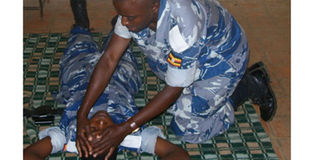Prime
Police get emergency training

Officers show some of the skills they acquired at the training. Police, as the main first respondents after accidents, need more than basic first aid skills. PHOTO BY EPHRAIM KASOZI.
The public might not be keenly conscious about how their efforts could cause secondary damage to victims of accidents when they try to help and rush them to hospital. Secondary injury can be a result of lack of skills on the part of first respondents after trauma.
A police trainer at Kabalye Police Training School in Masindi District, says the police have been offering emergency medical services (EMS) but without training; “We have been picking victims and rushing them to the hospital, not knowing that we could prevent death or secondary injury.”
Over 200 officers and cadet trainees have undergone training on advanced emergency response at the training school to equip officers and trainees with basic life support, an initiative by Medical Teams International (MTI), a worldwide volunteer organisation that provides mobile clinics to camps and communities.
According to Ms Kris Hurst, a US-based EMS trainer, the first responder training is aimed at changing the image of the Force in executing its duties. It has equipped officers with basic skills of taking care of bleeding, fractures and the ability to assess the condition of the victim before rushing them to the hospital.
“This is a paradigm shift in the operation of the Force on public safety. Officers should be responding with basic knowledge on how to stop preventable death as well as avoiding secondary injury in handling the victims,” says Ms Hurst. She adds: “We have provided training equipment for the training school to enable another group of trainees get skills on EMS. Now an officer will have several skills at work.”
Mr Denis Omodi Ayela, the MTI programme coordinator in charge of emergency medical services, explains that the training was aimed at equipping officers with basic health skills because they are exposed to occupational hazards.
“Our intervention is to equip officers on patrol trucks and traffic officers with skills of transportation, basic life support to prevent secondary injuries that usually occur in the process of help.
“We have held training of trainers but also we have since decided to train the entire force,” said Mr Ayela, adding that they are targeting at least half of the Force by the end of three years.
Ms Hadija Namutebi, the Deputy Commandant of the Police Training School described the training as a timely initiative coming alongside the initial police course. “The selection is critical as it is for the entire force. Even before traffic officers arrive at the scene, patrols are there but the training is a big boost in the work,” said Ms Namutebi while handing over certificates to the officers who attended the training.
She asked the trainers to enhance the training to already on job officers in their respective units to help them acquire the skills to take advantage of the course to meet their challenge.
If you come across a road accident ...
1. Stay safe and keep calm. Assess the situation: what are the dangers? (These might include approaching traffic, leaking petrol, broken glass etc). Make sure you stay safe: keep off the road. If you need to stop approaching cars, signal to them from the pavement. If you are in a car and you come across an accident, first park safely and turn off the engine before you get out to help. Use a hazard triangle if necessary. Get help from bystanders.
2. Check the airway. If it is safe to approach the injured person, do so, but don’t move them. Learn how to open an airway. Check for a response – talk to them and tap them gently. If there’s no response, shout for help. Check the casualty’s airway: put your hand on their forehead and gently tilt their head back.
3. Gently lift their chin with two fingers. Check if they’re breathing by listening and feeling for breath on your cheek. See if their chest is moving up and down. If they’re not breathing normally, you will need to start cardio pulmonary resuscitation. Learn how to resuscitate.




